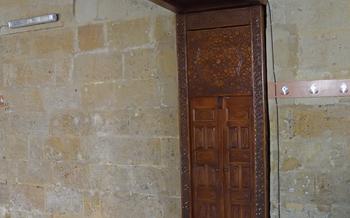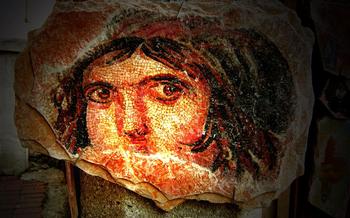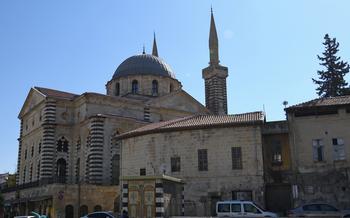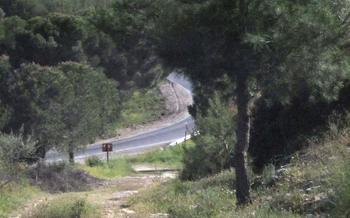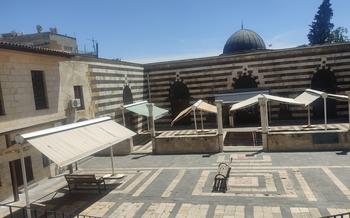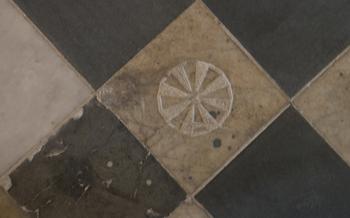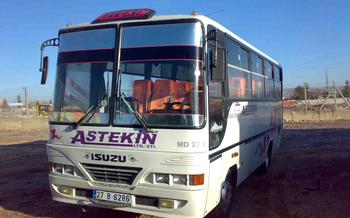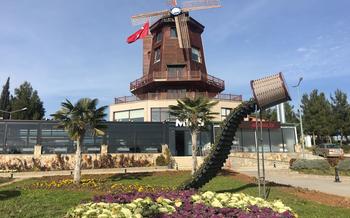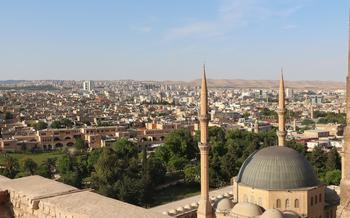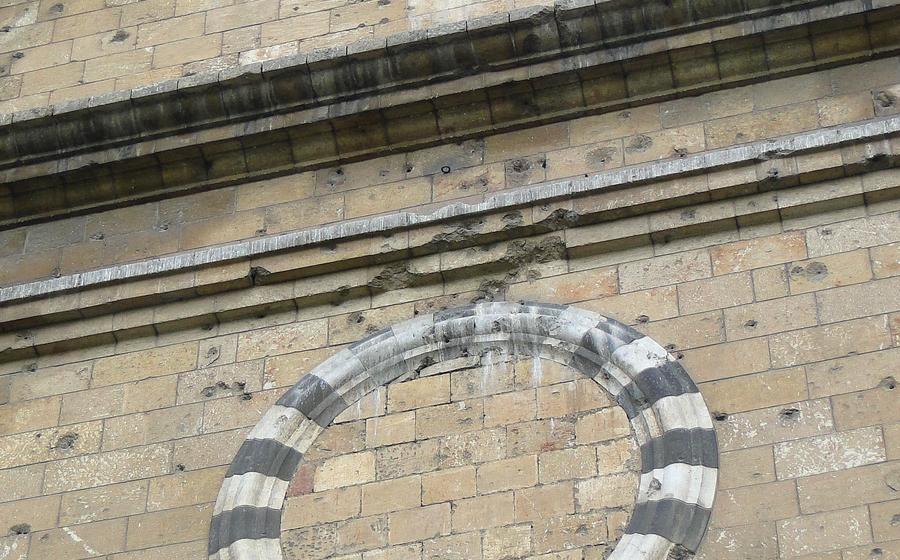
Kendirli Church
- Historical Significance
- Architectural Features
- Interior Decorations
- Religious Importance
- Excavation and Restoration
- Unique Features
- Symbol of Tolerance
- Cultural Events
- Local Craftsmanship
- Visitor Information
- Photography and Videography
- Souvenirs and Local Products
- Local Cuisine
- Budget Tips
- Insider Tip: A Hidden Gem
Historical Significance
Situated amidst the ancient city of Gaziantep, the Kendirli Church stands as a testament to the rich cultural and religious heritage of the region. Constructed in the 6th century AD, the church boasts a remarkable history that has intertwined with the rise and fall of civilizations. Built by Assyrian Christians, it served as a spiritual hub for the local community, becoming an integral part of their religious and cultural identity.
During the Mongol invasion of 1260, the church faced abandonment and fell into disrepair. The ravages of time and neglect obscured its grandeur, leaving it forgotten for centuries. However, in the 19th century, the church was rediscovered, revealing its hidden treasures and sparking renewed interest in its historical significance.
Today, the Kendirli Church stands as one of the oldest churches in the region, earning its place as a protected cultural monument. Its endurance through the centuries serves as a reminder of the resilience and continuity of faith amidst the ebb and flow of history.
Architectural Features
The Kendirli Church boasts an intriguing architectural style, blending Byzantine influences with local traditions to create a unique masterpiece. Its cruciform plan, typical of early Christian churches, adds a distinct character to the structure. The domed roof rises gracefully above, symbolizing the heavens and providing a sense of spaciousness within. The well-preserved apse, a semicircular niche located at the eastern end of the church, adds to the overall symmetry and grandeur of the building.
The exterior of the church is adorned with intricate stone carvings and decorative elements that showcase the skill and artistry of its builders. Floral motifs, geometric patterns, and biblical scenes are skillfully etched into the stone, adding a layer of depth and symbolism to the church's facade. The interior walls are adorned with vibrant frescoes and paintings that depict biblical stories and religious figures, creating a visually captivating and spiritually uplifting atmosphere.
Beneath the church lies a network of underground chambers and tunnels, believed to have served as hiding places for persecuted Christians during turbulent times. These hidden spaces add a layer of intrigue and mystery to the church's history, inviting visitors to explore its hidden depths and imagine the lives of those who sought refuge within its walls.
Interior Decorations
Inside the Kendirli Church, a breathtaking collection of frescoes and paintings adorns the walls, narrating biblical scenes and stories with vibrant colors and expressive brushstrokes. These artworks, created by skilled artists with devotion, depict significant moments from the Bible, offering a glimpse into the church's history and beliefs. The walls come alive with scenes of Jesus' life, the apostles' journeys, and symbolic representations of faith and salvation. The intricate details and masterful techniques showcased in these paintings captivate visitors, inviting them to delve deeper into the church's rich spiritual heritage.
A particularly striking feature of the interior is the presence of an iconostasis, a beautifully carved wooden screen separating the sanctuary from the nave. This elaborate structure, adorned with intricate designs and religious iconography, serves as a symbolic threshold between the sacred and the secular realms. The iconostasis features a series of icons, each depicting a different saint or religious figure, adding to the overall grandeur and spiritual significance of the church's interior.
Religious Importance
The Kendirli Church holds significant religious importance as a place of worship for the local Christian community, particularly the Assyrian Orthodox Church. For centuries, the church has served as a spiritual center for the Assyrian Orthodox community, providing a sacred space for prayer, contemplation, and religious ceremonies. The church's annual festivals and celebrations, such as the Feast of the Cross and the Easter Vigil, attract a large number of faithful who gather to celebrate their faith and traditions. Despite the challenges and persecution faced by the Christian community throughout history, the Kendirli Church continues to stand as a symbol of resilience and devotion, serving as a testament to the strength and continuity of the Assyrian Orthodox faith in Gaziantep.
Excavation and Restoration
In recent years, the Kendirli Church has undergone extensive excavation and restoration work, meticulously preserving its historical and cultural significance. Archaeologists and conservators have dedicated themselves to uncovering the church's hidden secrets and returning it to its former glory.
The excavation process presented numerous challenges, requiring the careful removal of debris and the stabilization of the church's structure. Experts worked tirelessly to ensure that the church's integrity remained intact while revealing its long-lost treasures.
Ongoing research and studies have shed light on the church's rich history and architectural features. Scholars have delved into the church's origins, construction techniques, and the significance of its unique elements. Their findings have contributed to a deeper understanding of the church's place in the region's cultural and religious landscape.
Through these meticulous efforts, the Kendirli Church has been transformed into a living testament to the enduring spirit of faith and resilience. It stands as a symbol of the dedication and expertise of those who have worked tirelessly to preserve its legacy for generations to come.
Unique Features
The Kendirli Church boasts several unique and distinctive features that set it apart from other churches in the region. One remarkable feature is the baptismal font carved directly into the church's floor. This well-preserved example of its kind is a testament to the church's rich history and the importance of baptism in the Christian tradition.
Another unique aspect of the Kendirli Church is the hidden chamber beneath the altar. This secret chamber is believed to have been used for secret religious ceremonies or as a hiding place during times of persecution. The existence of this hidden chamber adds an air of mystery and intrigue to the church's already fascinating history.
Finally, the Kendirli Church is renowned for its exceptional acoustics. The church's unique architectural design and construction materials create a resonant and immersive atmosphere during services and performances. This acoustic phenomenon enhances the spiritual experience for worshippers and creates a memorable and awe-inspiring ambiance for visitors.
Symbol of Tolerance
The Kendirli Church stands as a testament to the religious tolerance and coexistence that has characterized Gaziantep throughout history. For centuries, Christians and Muslims have lived side by side in the city, respecting each other's beliefs and customs. This harmonious coexistence is exemplified by the Kendirli Church, which has been preserved and protected by both Christian and Muslim communities. The church serves as a symbol of mutual respect and understanding, reminding visitors of the importance of religious tolerance and peaceful coexistence.
Local authorities and community groups have played a crucial role in promoting interfaith dialogue and understanding in Gaziantep. Various initiatives, such as interfaith events, workshops, and educational programs, are organized to foster harmonious relations between different religious communities. The Kendirli Church, with its rich history and symbolic significance, is a focal point for these efforts, bringing people together to celebrate their shared heritage and promote a culture of respect and tolerance.
Cultural Events
Beyond its religious significance, the Kendirli Church serves as a vibrant hub for cultural events and activities, showcasing its multifaceted role in the community. Throughout the year, the church's premises play host to a diverse array of programs that celebrate its rich history and heritage.
Concerts featuring talented local musicians fill the air with enchanting melodies, transforming the church into an intimate concert hall. Historical reenactments bring to life the stories of the past, allowing visitors to experience the church's legacy in a tangible way. Art exhibitions showcasing the works of local artists adorn the church's walls, creating a visually captivating display.
These events not only serve to preserve and promote the cultural heritage of the Kendirli Church but also foster a sense of community and belonging among visitors and locals alike. The church becomes a melting pot of cultures, where people from all walks of life come together to appreciate the arts, explore history, and celebrate the diversity of Gaziantep.
Local Craftsmanship
The Kendirli Church showcases intricate craftsmanship and artistry that reflects the rich cultural heritage of Gaziantep. Local materials, such as stone, wood, and ceramics, were meticulously used in the construction and decoration of the church. Skilled artisans, including masons, carpenters, and painters, poured their hearts and souls into creating the church's unique features. The intricate stone carvings adorning the exterior and interior of the church are a testament to their exceptional skills. The vibrant frescoes and paintings that adorn the walls showcase the artistic prowess of the region's masters. Preserving and supporting traditional craftsmanship techniques associated with the church is crucial to maintaining the authenticity and cultural significance of this architectural gem. Visitors can admire the exquisite craftsmanship and artistry that went into the creation of the Kendirli Church, appreciating the dedication and skill of the local artisans who brought this masterpiece to life.
Visitor Information
Planning a visit to the Kendirli Church is easy and rewarding. Situated in the heart of Gaziantep, the church is accessible via public transportation or private vehicles. Visitors can easily reach the church by taking a short bus ride or taxi from the city center. Once there, ample parking space is available for those arriving by car.
Upon arrival, visitors are greeted by a friendly and knowledgeable staff who provide guided tours in multiple languages. These tours offer a deeper insight into the history, architecture, and religious significance of the church. Brochures and multilingual signage are also available for self-guided exploration.
When visiting a religious site, it is important to observe appropriate dress code and etiquette. Visitors are expected to dress respectfully, covering shoulders and knees. Photography and videography are permitted inside the church, but visitors are kindly requested to obtain permission beforehand and to be mindful of the sanctity of the space. The church also offers professional photography services for those seeking high-quality images for personal or commercial use.
Photography and Videography
Visitors to the Kendirli Church are welcome to take photographs and videos to capture the beauty and historical significance of the site. However, it is important to respect the sanctity of the church and observe proper etiquette when doing so. Permission should be obtained from the church authorities or guides before taking any photographs or videos, especially during religious services or ceremonies. Visitors are asked to be mindful of other visitors and avoid using flash photography or making excessive noise that may disturb the peaceful atmosphere of the church. Tripods and other photography equipment should be used with discretion and without obstructing the movement of other visitors or blocking important features of the church. By adhering to these guidelines, visitors can ensure that they capture beautiful and respectful images of the Kendirli Church while respecting its religious significance and the privacy of others.
Souvenirs and Local Products
When visiting the Kendirli Church, don't miss the opportunity to support local artisans and businesses by purchasing authentic souvenirs. Near the church, you'll find a variety of shops and markets offering a treasure trove of traditional handicrafts, jewelry, pottery, and local delicacies. From intricately woven carpets and textiles to hand-painted ceramics and copperware, there's something for every taste and budget.
When bargaining for souvenirs, remember that it's a part of the local culture and a way to connect with the vendors. Don't be afraid to negotiate politely, but always be respectful and fair. Your purchases contribute to the preservation of traditional craftsmanship techniques and support the livelihoods of local artisans.
Indulge your sweet tooth with the famous Gaziantep baklava, a flaky pastry filled with layers of nuts and sweetened with honey syrup. For a savory snack, try the crispy lahmacun, a thin flatbread topped with minced meat, vegetables, and spices. And don't forget to sample künefe, a delightful dessert made with shredded filo dough, cheese, and sweet syrup.
As you explore the vibrant streets surrounding the Kendirli Church, soak in the local atmosphere and immerse yourself in the rich cultural tapestry of Gaziantep. Embrace the flavors, sights, and sounds of this captivating city, and take home a piece of its charm through the unique souvenirs you'll find.
Local Cuisine
Gaziantep, the home of the Kendirli Church, is renowned for its rich and diverse cuisine, a true feast for the senses. The city's culinary traditions have been shaped by centuries of cultural exchange and influences from various civilizations, resulting in a unique and delectable blend of flavors.
When visiting the Kendirli Church, take the opportunity to explore the nearby restaurants and eateries, where you can savor the authentic flavors of Gaziantep. Indulge in mouthwatering kebabs, grilled to perfection and seasoned with aromatic spices. Try lahmacun, a crispy flatbread topped with minced meat, vegetables, and herbs, a local delicacy not to be missed.
For a sweet treat, satisfy your cravings with baklava, layers of filo pastry filled with chopped nuts and sweetened with syrup, or künefe, a cheese-filled pastry topped with shredded phyllo dough and drizzled with sweet syrup.
Sampling the local cuisine is an essential part of immersing oneself in the cultural heritage of Gaziantep. By savoring the city's culinary delights, you'll create lasting memories and gain a deeper appreciation for the region's rich history and traditions.
Budget Tips
For budget-conscious travelers, exploring the Kendirli Church and Gaziantep is entirely possible. Public buses and shared taxis offer affordable transportation options to reach the church. Several guesthouses and hostels near the church provide budget-friendly accommodation. Instead of dining at restaurants, try local street food and markets for delicious and budget-friendly meals. Explore other attractions in Gaziantep that are free or low-cost, such as museums, parks, and historical sites. Take advantage of free walking tours or guided tours with affordable rates to learn more about the city's history and culture. Remember, traveling on a budget doesn't mean compromising on experiences; it's about embracing the local culture and finding creative ways to explore.
Insider Tip: A Hidden Gem
One of the lesser-known secrets of the Kendirli Church is the existence of a hidden chamber beneath the altar. This chamber, believed to date back to the early days of the church's construction, is said to have been used for secret religious ceremonies and as a refuge during times of persecution. While not always open to the public, visitors who are fortunate enough to gain access to this hidden space can experience a glimpse into the church's rich history and the resilience of the Christian community in Gaziantep.
